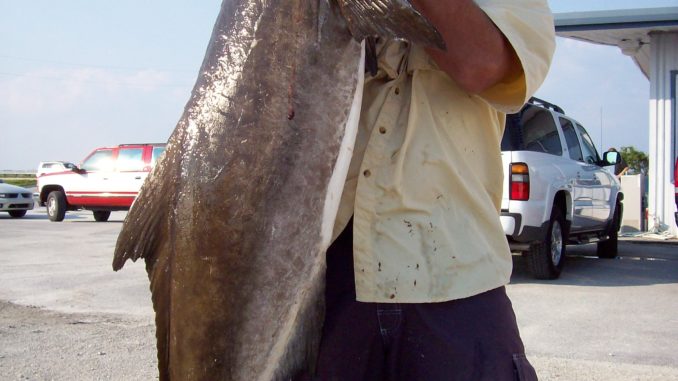
Side-scan sonar technology has made it easier to find cobia. Making them bite is another problem, however.
A clear sky and a calm wind beckoned as Mike Taylor loaded his boat at a private dock in Morehead City for a day on the water. He was especially happy because there had been no pre-dawn alarm, and even the sun appeared to be smiling. Because of the fish he had chosen to target, being on the water before daylight wasn’t essential.
“The best time to catch a cobia is between about 9 a.m. and 2 p.m.” said Taylor, who operates Taylor-Made Charters. “The position of the sun dictates how well you can see them.”
In May, Taylor primarily targets cobia, so as soon as he navigated through the Intracoastal Waterway and Beaufort Inlet into the open ocean, the first order of business was checking for cobia around the buoys marking the shipping channel.
“Cobia are attracted to any type of structure,” he said. “I always look around the buoys and down into the water below them. A cobia may be circling the buoy at the surface or holding down as deep as the bottom.”
Taylor’s bay boat has a second helm, a modified tower that puts him well above the surface, a big advantage when it comes to seeing down into the water, looking for cobia.
“I can see a cobia right beside the buoy,” he said. “Let’s see if he’s interested.”
Taylor cast a pre-rigged artificial eel on the near side of the buoy, making sure the cobia couldn’t wrap the line around the buoy or its mooring cable if it decided to strike.
“A cobia is a powerful fish,” he said. “I fish a tight drag, cranked down as much as the line and leader can withstand without breaking. Most of the time, he doesn’t have anything to snag the line on, but when you fish around a buoy, you have to think about where the fish is in relation to the structure before making a cast. You can maneuver the boat into position because, if he’s on structure, he won’t move very much. A cobia usually shows no fear of a boat.”
The cobia looked the lure over several times, but did not strike it. Taylor said that some days, cobia are in a finicky mood, and on other days, they charge any bait presented properly.
“If you hit the fish with the lure, he’s going away from here,” he said. “You want to cast it about 10 to 15 feet in front of the fish and beyond it. When you retrieve it in front of his face, that’s when he is going to hit it if he’s going to at all.”
The fish moved away and Taylor made a cast with an artificial eel rigged on a heavy jighead, allowing it to sink. He bounced it up and down beside the buoy before retrieving it. No fish was following it, so he started cruising to the south.
Another angler who often fishes with Taylor is Jeff Cronk of Fish’n 4 Life Charters. Cronk fishes the same waters, which he said are bounded by Bogue Inlet on the south and Cape Lookout on the north.
“You want the sun at your back or overhead,” Cronk said. “That means heading out of Beaufort Inlet and traveling southward in the morning and heading back toward Cape Lookout in the afternoon. You want to face the beach in water about 40 feet deep and up to a mile offshore. That way, you can see the cobia against the bottom when they push up into shallow water. Our fish come inshore from the Gulf Stream, where they over-winter. We catch the first wave coming off the break and, later on, we get a push of fish coming up from the south as they are migrating up to Cheaspeake Bay to spawn.”
Cronk’s boat doesn’t have a tower, rather, he depends upon the latest technology to find cobia. Side-scan sonar is revolutionizing many types of fishing and costs much less than the price of a second helm.
“I’m using down-imaging, side-scan sonar, the Lorance HDS Generation 2 Structure Scan,” he said. “It gives a 3-D imaging of the bottom and side-imaging of menhaden schools so we can see the cobia working inside and below schools of menhaden. It allows you to see any big fish. You can’t tell difference between a cobia and a single shark, but you know a big fish is in there with the bait. With experience, you tell if there is a school of sharks and avoid making a cast that will waste your time and result in a lost lure.”
Taylor has seen cobia follow menhaden schools, turtles and schools of rays. They also move along tide lines near the inlets. Taylor said the best thing to find them around is often a large sea turtle.
“If you see a leatherback, the odds are 50-50 that one or more cobia will be swimming around it,” Taylor said. “I think it’s because it is so big and offers a lot of shade. There might be hundreds of menhaden schools between Cape Lookout and Bogue Inlet, but only a small percentage of them will have cobia on them. The side-scan sonar helps eliminate a lot of them.”
When checking out a menhaden school with sonar or when casting to try to entice a cobia strike, both Taylor and Cronk use an electric trolling motor.
“It doesn’t scare the menhaden (and) you don’t have to worry much about the cobia,” Taylor said. “They usually don’t pay any attention to the boat, unless they follow the lure right up to it. Then, they might turn away when they see you moving around, jigging the rod.”
When he fishes a menhaden school, Taylor casts beyond the baitfish, allows the lure to sink 10 or 15 feet, then starts jigging the eel back to the boat. He sets the hook on anything that feels like a strike. With practice, he said an angler learns to tell the difference between the vibration of menhaden hitting the line and a cobia striking the lure.
“When a cobia strikes, you have to hit him hard,” Taylor said. “You won’t break the line if the drag is set light enough, so you set the hook hard the instant you feel the strike. It’s so exciting seeing a cobia charge the lure that a lot of times, the angler sets the hook before he feels the fish. If you jerk it away from the fish, he might lose interest on follow up casts.”
Often, a fish follows the lure all the way to the boat, then sounds without striking it, so Cronk always has a live-bait rig handy.
“I grab a menhaden from the livewell and put it on a single-hook rig to pitch it to the fish,” he said. “If he doesn’t strike the lure, he is probably not going to hit it if you present it to him again, (but) he usually won’t turn down the live bait. I also put a live bait down about 15 feet as a hooked cobia tires and comes to the boat. The hooked fish usually has others following it that will strike the menhaden even if you can’t see them. It works especially well when you are fishing wrecks; you can use the technique with an amberjack. If you tire an amberjack and tie him off down 10 to 15 feet, amberjack and cobia will come to investigate. You pitch the bait to the cobia and try to miss the amberjack.
“Most days, we cast to 30 or 40 cobia and catch from one to five,” he said. “I’ve had as many as five hooked up at one time and caught 40 in one day. I have seen cobia schools that were 50 yards long, 50 yards wide and going down all the way down to the bottom. I have seen days they would strike anything you put in front of them then again, I have seen days when you can’t get a good bite, (but) it’s rare when we don’t catch at least one or two.”
DESTINATION INFORMATION
HOW TO GET THERE — US 70 is the main route into Morehead City from points west. A public ramp behind the Visitors Center and N.C. Department of Marine Fisheries headquarters on US 70 is very convenient for most fishermen. Public ramps on Radio Island and at Town Creek in Beaufort also offer good access to the cobia grounds.
WHEN TO GO — The best cobia fishing begins in May and will usually last into early June.
BEST TECHNIQUES — When pitching to cruising cobia, a Powerbait or Gulp eel rigged on a 2- or 3-ounce bucktail jib works. You can also pitch live menhaden on a 6/0 to 8/0 circle hook attached almost 50- to 60-pound fluorocarbon leader. Use a Uni-Knot to connect leader to line instead of a swivel. A 7-foot, Penn Rampage jigging stick is a great rod, mated with a Penn 5500 Spinfisher reel spooled with 30- to 40-pound braid.
FISHING INFO/GUIDES — Capt. Mike Taylor, Taylor-Made Charters, 252-725-2623. Capt. Jeff Cronk, Fish’n 4 Life Charters, 336-558-5697. See also Guides and Charters in Classifieds.
ACCOMMODATIONS — Quality Inn, Morehead City, 252-247-3434; Hampton Inn, Morehead City, 252-240-3100; Holiday Inn Express, Morehead City, 252-247-5001; Doubletree Inn, Atlantic Beach, 252-240-1155; Windjammer Inn, Atlantic Beach, 252-247-7123; AmeriSuites, Atlantic Beach, 252-247-5118; Crystal Coast Tourism Authority, 252-726-8148, www.crystalcoastnc.org
MAPS — Sealake Fishing Guides, 800-411-0185, www.thegoodspots.com; Grease Chart, 800-326-3567, www.greasechart.com; Maps Unique, 910-458-9923, www.mapsunique.com; GMCO Chartbook of North Carolina, 888-420-6277, www.gmcomaps.com.

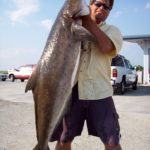
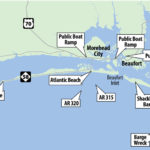
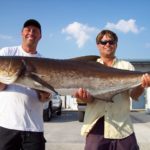
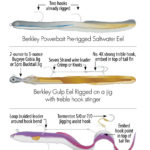



Be the first to comment